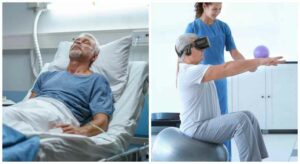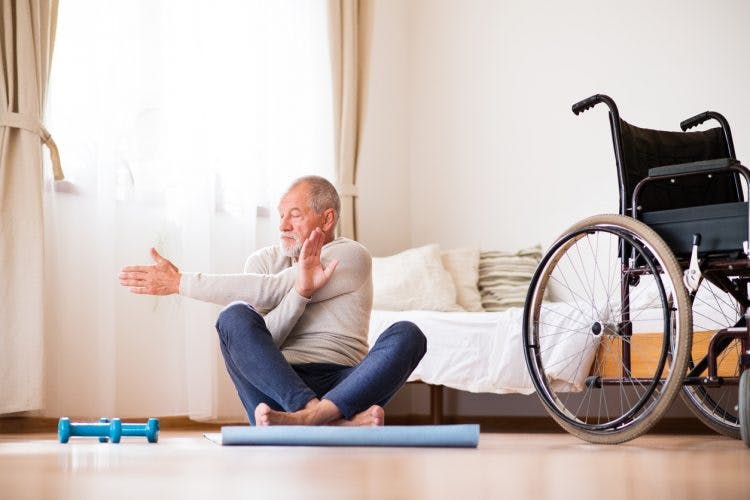If you or a loved one has recently suffered a stroke, you may be wondering what type of rehabilitation is available. One popular option is physical therapy. Physical therapy can help improve mobility and function in patients who have suffered a stroke. In this blog post, we will discuss the benefits of physical therapy for stroke patients and provide some tips on how to find the best physical therapist for your needs.
Contents
- 1 What Is Stroke?
- 2 What Is the Purpose Of Physical Therapy For Stroke Patients?
- 3 What Are the Types of Physical Therapy for Stroke Patients?
- 3.1 Mirror Therapy for Hand Recovery
- 3.2 Constraint-Induced Movement Therapy
- 3.3 Massage therapy
- 3.4 Electrical stimulation
- 3.5 Ultrasound therapy
- 3.6 Cognitive rehabilitation
- 3.7 Aqua therapy
- 3.8 Balance training
- 3.9 Range of motion exercises
- 3.10 Strengthening exercises
- 3.11 Endurance training
- 3.12 Gait training
- 4 How Does Physical Therapy Help Stroke Patients?
- 5 Limitations And Concerns
- 6 Conclusion
What Is Stroke?

A stroke occurs when the blood supply to your brain is interrupted or reduced. This can happen if a blood vessel in your brain bursts or if one of your arteries becomes blocked. When this happens, part of your brain doesn’t get the oxygen it needs, and the cells in that part of your brain begin to die.
What Is the Purpose Of Physical Therapy For Stroke Patients?
The purpose of physical therapy for stroke patients is to help them regain as much function and movement as possible. Physical therapists work with stroke patients to achieve the best possible functional outcome.
Physical therapy is a vital part of the rehabilitation process for stroke patients The use of physical therapy for stroke patients are as follows:
- To help the patient regain as much movement and function as possible
- To help the patient cope with any residual physical limitations
- To help the patient adjust to living with a disability
- To prevent or treat secondary complications that can result from strokes, such as contractures, pressure sores, and joint problems
What Are the Types of Physical Therapy for Stroke Patients?

There are many different types of physical therapy that can be used to help stroke patients achieve their rehabilitation goals. Some of the most common types of physical therapy for stroke patients include:
Mirror Therapy for Hand Recovery
It is a type of physical therapy that uses a mirror to reflect the unaffected side of the body, making it appear as if the affected side is working correctly. This therapy can be used to help stroke patients recover movement and function in their affected hands.
Constraint-Induced Movement Therapy
Constraint-induced movement therapy is a type of physical therapy that involves constraining the unaffected arm in order to force the use of the affected arm. This type of therapy can be used to help stroke patients regain function in their affected arm.
- Bobath Approach: The Bobath approach is a type of physical therapy that focuses on helping stroke patients regain normal movement patterns. This approach is often used in conjunction with other forms of therapy, such as constraint-induced movement therapy.
- Plyometrics: Plyometrics is a type of exercise that involves explosive movements, such as jumping or hopping. This type of exercise can help stroke patients improve their balance and coordination
Massage therapy
Massage therapy can be used to help reduce pain and muscle spasms, and increase range of motion. It can help stroke patients who have trouble moving their arms or legs.
Electrical stimulation
This type of physical therapy for stroke patients uses electrical impulses to help stimulate muscle contractions and improve the range of motion. For instance, if a patient has paralysis on one side of their body, electrical stimulation can help them regain movement in that area.
Ultrasound therapy
Ultrasound therapy uses sound waves to help reduce inflammation and increase blood flow to the affected area. It works by sending sound waves into the body. These sound waves then bounce off of the tissues and create vibrations. These vibrations help to reduce inflammation and increase blood flow to the affected area.
Cognitive rehabilitation
Cognitive rehabilitation is a type of physical therapy that helps stroke patients with any cognitive impairments that they may have, such as trouble with memory, attention, or problem-solving. For instance, a therapist may use memory games or other exercises to help a patient improve their cognitive skills.
Aqua therapy
The first step in physical therapy for stroke patients is to regain movement and strength in the arms and legs. This process begins with Aqua therapy. In the water, the weight of the body is supported by the water, which allows patients to move their limbs more easily. The warmth of the water also helps to relax muscles and reduce pain.
Balance training
Balance training is a type of physical therapy that helps stroke patients improve their balance and coordination. It works by helping patients relearn how to control their body movements. This training is often done with the help of a physical therapist, who can provide guidance and support.
Range of motion exercises
Range of motion exercises is a type of that helps stroke patients improve their flexibility and range of motion. They work by helping patients stretch and move their muscles in a controlled way. These exercises are often done with the help of a physical therapist, who can provide guidance and support.
Strengthening exercises
Strengthening exercises are a type of physical therapy that helps stroke patients improve their muscle strength. They work by helping patients use their muscles in a controlled way to build strength. Strengthening exercises are often done with the help of a physical therapist, who can provide guidance and support.
Endurance training
Endurance training is a type that helps stroke patients improve their stamina and endurance. It works by helping patients learn how to pace themselves during activities. Endurance training is often done with the help of a physical therapist, who can provide guidance and support.
Gait training
It is a type of physical therapy that helps stroke patients improve their Walking ability. Gait training may involve using a walker or cane, and working on balance and coordination. Patients may practice walking heel-to-toe, or walking in a square pattern.
How Does Physical Therapy Help Stroke Patients?
Physical therapy helps stroke patients. Some of the most common benefits of physical therapy for stroke patients include:
Reduced pain and swelling
One of the most common benefits of physical therapy is that it can help to reduce pain and swelling. This is especially important for stroke patients, as they often experience a great deal of both.
Improved mobility
Another common benefit of physical therapy is improved mobility. This is again particularly important for stroke patients, as many will lose some degree of mobility after suffering a stroke.can help stroke patients regain movement and function.
Increased strength
Physical therapy can also help to increase strength, which is often greatly reduced after a stroke. This increased strength can help patients to regain some of their lost mobility and independence.
Improved balance
Balance is often an issue for stroke patients, as the stroke can affect the brain’s ability to control the muscles that keep us balanced. Physical therapy can help to improve balance and prevent falls.
Improved coordination
Similar to improved balance, physical therapy can also help with coordination. This is again due to the fact that the stroke can affect the brain’s ability to control the muscles needed for coordinated movement.
Improved cardiovascular fitness
Physical therapy can help to improve cardiovascular fitness, which is often impaired after a stroke. This is important for overall health and well-being.
Improve overall life
There are many things that can help patients with post-stroke. For example, regaining mobility and movement in the limbs, as well as improving coordination. In addition, physical therapy can also help with speech and language rehabilitation, as well as helping to improve cognitive function.
In order to maximize the benefits, it is important to work closely with a physical therapist who is experienced in working with stroke patients. The therapist will design a personalized treatment plan based on the individual’s needs and goals.
Limitations And Concerns
There are various limitations of physical therapy for stroke patients. they are as follows:
1. There is a lack of evidence to support the efficacy for stroke patients in terms of long-term functional outcomes.
2. There is a lack of standardization in terms of the types of exercises and intensity levels that should be used for stroke patients.
3. There is a risk of further injury or complications associated with for stroke patients, especially if the exercises are not performed correctly or the intensity levels are too high.
4. There is a lack of insurance coverage for stroke patients in many cases.
5. There is a lack of trained and experienced therapists in many areas, which can make it difficult to find someone who can provide appropriate care.
Thus, physical therapy for stroke patients must be approached with caution and only after consulting with a medical professional.
If you are considering physical therapy for stroke patients, it is important to talk to your doctor about the risks and benefits.
Conclusion
It may be concluded that physical therapy for stroke patients is an important part of the recovery process.. Physical therapists work closely with stroke patients to develop individualized treatment plans. Depending on the severity of the stroke, physical therapy may be a long-term commitment. However, the ultimate goal of physical therapy is to help the stroke patient regain as much function and independence as possible.
Talk to your doctor or a physical therapist to learn more about what types of physical therapy might be appropriate for you or your loved one after a stroke.
Physical Therapy help patients recover from pain. If you’re experiencing Back pain, Shoulder pain, Knee pain, Neck pain, Elbow pain, Hip pain, or Arthritis pain, a physical therapist at MantraCare can help: Book a physiotherapy session.


